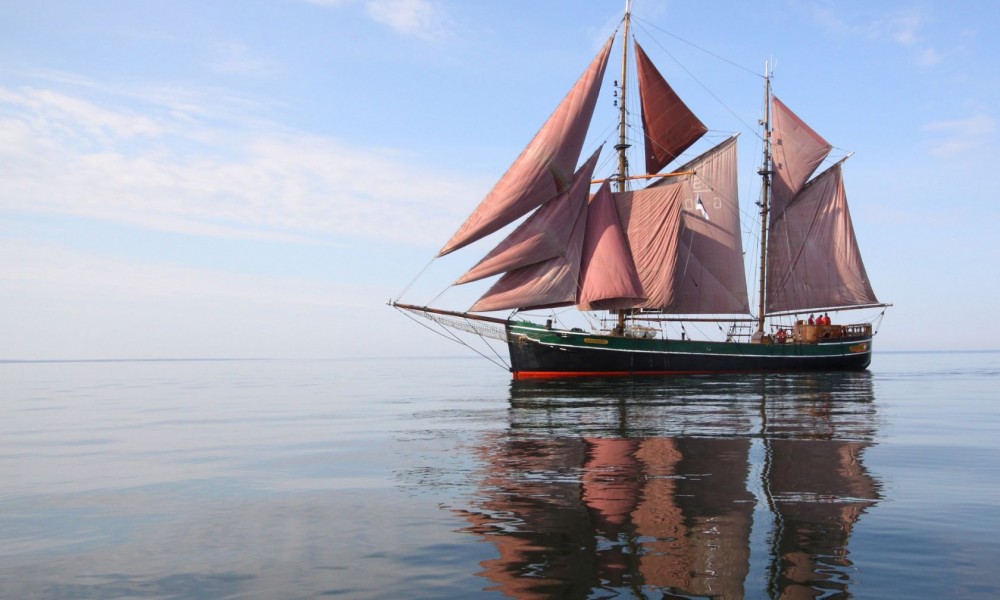Along the waves of time: historic Sailing vessels of Estonia

Occasionally old sailing vessels return from the abyss of past to invite adventurers aboard.
Estonia has been of high standing among admirers of reasonably-priced time-off near water. Low cost of renting a yacht, cozy near-shore villages and picturesque routes with free parkings in reserved areas all make heads of modern-day Cooks and Hooks swirl. When every island, river and lake is roamed length and breadth it remains to slide along waves of time having freighted a sailing vessel of an era to own heart's content.
Estonian shipbuilders have reached the acme of skills in restoration of sails vessels. For the first time in several hundred years, sailboats, frigates and schooners triumphantly returned to the vast of water after being trapped within walls of museums – upon receiving an approval for good work in the sphere of tourism. Title of patriarch of sailing fleet of Estonia is currently born by two-masted schooner Blue Sirius over a hundred years old that belongs to children foundation Tuletorn Fond. Year after year historic sailing vessels shine during summer festivals "Maritime Days" in Tallinn, evoking thunder of applause without fail.Photo 1.bp.blogspot.com
Crucial role in resurrection of old ships was played by efforts of enthusiasts of Wooden Ship Society Vikan, who recreated technologies of the past based on annals and chronicles. First major success of Estonian renovators became participation in a large international reconstruction project by a merited schooner Hoppet built in 1926 in Spithami village. In 1928 the vessel was sold to Finland and little short of forty years had diligently transported grains and potatoes to be sent to retirement to Stockholm afterwards, where it is used for educational and entertainment purposes.
Priceless lessons didn't go up in smoke. Having gained some experience, craftsmen renewed to operational conditions punt Gättor, discovered on Vormsi Island, populated by the Swedes – descendants of Scandinavian conquerors, who flowed to Estonia for wood in 5th – 6th century. However, Varangian guests lashed out on compensation of damage by teaching people of the woods subtleties of shipbuilding.
On a distant Ruhnu Island in the vicinity of Latvian border light single-masted yawl Runbjar dwells, built in our days in compliance with traditional technology of Swedes-islanders; kindergarten combat of the vessel was financed by TELE2 Company. Now the yawl pays off its start in life with tours around small islands and nestlings of rare bird species. Moonzund Bay is patrolled by a huge single-masted sailing vessel, designed by same craftsmen in the image and likeness of military ships of times of Gustav Vasa.
In Tartu sail-and-row boat Turm is well-known, created for kicks of enthusiasts of historic re-enactment and role plays. In summer on board the ship large-scale naval battles depicting lives of Vikings are played. After a short basic training anyone who feels strong enough to manage a hatchet, a two-handed sword or heavy wet ropes can join the battle. No dummies or indulgence for sedentary life style – weapons and armor of re-enactors are all recreated in compliance with 7th century technologies. Still, among valiant combatants sometimes a couple of Valkyries can be discovered who manage swords just as good as men do. And if calm leisure in quite and peace is more to your liking, climb up Hanseatic barge Jõmmu and head down the Emajõgi River through Lake Võrtsjärv to meet endless vast of Lake Peipus. Photo by Kalev Vask commons.wikimedia.org
Photo by Kalev Vask commons.wikimedia.org
Own drakkar is preserved at the famous “village of captains” Käsmu that bred more than one generation of sailors. Alumni of local naval college became skippers and obtained manors and households; near-border village turned into a lively marine city that later caught fancy of prominent literature men. To inspire servants of muses, employees of Käsmu Sea Museum built Varangian battle sail ship Aimar in 2010, following instructions from chronicles. When a group of six strong oarsmen gets assembled of visitors of the museum, the ship hoists her predator-looking oblique sail and gains the offing to dissect waves with a carved snake-headed stempost. Upon a trip travelers are offered to chop a golden coin with own hands in support of the project.
Gaff-headed schooner Kajsamoor, that originated in Norway and was floated out in 1939, became a talisman of Estonian historic shipbuilding. Having wandered in the North Sea, this fishing vessel, worn out by storms, anchored in Kalamaja and came in sight of renovators. Interior was ennobled with wooden lining and modern furniture and over well-shaped masts scarlet sails of triumphant dream spread. Captain Herkki Haldre knows word-perfect romantic novels of Alexander Grin and speaks great Russian, keeping a bunch of marine tales, spicy cocktails with rum and odorous fish broth of freshly-taken fish at hand. Photo visitestonia.com
Photo visitestonia.com
Over entire navigation season fairytale sailing vessel is on duty in safe haven of air harbor, inviting guests of Estonian capital to have a voyage around Tallinn Bay. When a team is gathered, the schooner sets on a journey to Åland Islands in Finland or Gotland Island in Sweden. By the way, a trip under scarlet sails has nothing to do with entertaining cruise: passengers actively participate in knotting and splicing, polish deck and stand abaft the wheel to go ashore as seasoned sea wolves.
Sailor’s initiation begins with tasting of a trademark drink of Estonian smugglers of times of the First Republic. After a knock-out dose of coffee, rum and vodka it isn’t that hard to take a night shift in pouring rain – you’ll have enough strength left for a get-together with dances in mess hall!
Cover photo freemapsofcornwall.co.uk





















